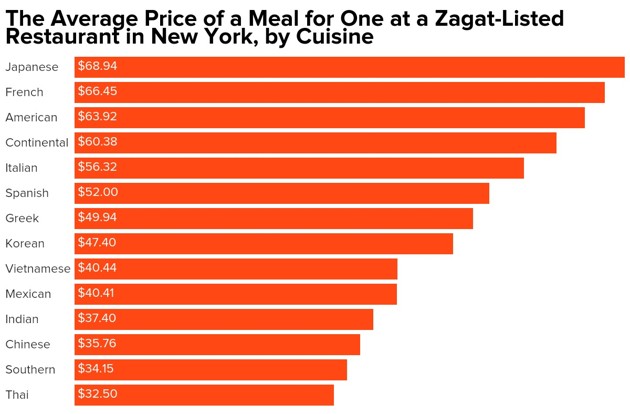An old gem from 2016 from the Atlantic. I've always wondered why we assign value and prestige to certain cuisines and others not. This lays out a pretty interesting theory.


The history of Italian cuisine:
How German used to be the crown "foreign" food:


"The shortest answer would be cultural prestige, some notion of an evaluation of another culture's reputation," says Krishnendu Ray, an associate professor of food studies at New York University. In a book published earlier this year, The Ethnic Restaurateur, Ray expands on this idea, sketching the tiers of what he calls a "global hierarchy of taste." This hierarchy, which privileges paninis over tortas, is almost completely shaped by a simple rule: The more capital or military power a nation wields and the richer its emigrants are, the more likely its cuisine will command high menu prices.
Consider the divergent trajectories of Japanese and Chinese cuisines in America. In the past few decades, Japanese cooking has become something to emulate in haute cuisine, with elite Western chefs frequently visiting Japan to observe how chefs there are preparing and plating their work. "Japanese is doing very well in terms of prestige, and that is about … the rise of Japan as a major economic power," Ray says. Meanwhile, he argues, the status of Chinese food remains held back by many Americans' perceptions of the country and its economy. "With China, [Americans] are still filled with this funny disdain, that it is about cheap and crappy stuff, including about cheap and crappy food," he says.
To great effect, he draws on data from Zagat, whose reviewers collect check prices for meals at the restaurants it lists (which tend to range from middlebrow to the lower end of high-end); in New York in 2015, the average check at a Zagat-listed Japanese restaurant for a meal for one (including a glass of wine and a tip) was $68.94, while the average price for the same thing at Zagat-listed Chinese restaurants was $35.76.
In 1985, the earliest year for which Zagat data is available, Japanese food had the sixth-highest average check price in New York. Last year, it ranked first. During that time, Greek and Korean have also seen their lots improve, while Chinese has remained at the lower end of the check-price spectrum, along with Thai, Indian, and Mexican.
The history of Italian cuisine:
The history of Italian food in America, meanwhile, offers a wonderful case study of how a cuisine's status is dictated by immigration patterns. As Ray details in The Ethnic Restaurateur, Italian food was first popularized in the U.S. in the 19th century. Thomas Jefferson had a high opinion of macaroni (and pasta in general), which at the time was not associated with cardboard boxes and bright orange powder, but rather with more refined cuisines, such as France's.
"Italian food would be dislodged," Ray writes in his book, "by the entry of new southern Italian immigrants between 1880 and 1924 who were numerous and mostly poor, hence derided by the taste-making elite." Italians were scorned as "garlic eaters," and by 1955, the status of their country's cuisine had fallen so far that the legendary cookbook author and food columnist James Beard wrote, "My opinion of Italian cookery was not too high." Technically speaking, Beard did, like those in Jefferson's time, compare it to French food, but unlike 19th-century gourmands, he compared it (unfavorably, no less) to the food the French served on trains.
How German used to be the crown "foreign" food:
For quite a while, in fact, "foreign" food was simply shorthand for German food. That's what writers in the Times meant virtually anytime they referred to foreign food between the 1850s, when the paper was founded, and around the 1920s. In the mid- to late 1800s, when relatively poor German immigrants were first arriving in the U.S. en masse, their sauerkraut and sausages were denied incorporation into the American culinary canon. Decades later, only after generations of Germans built wealth and social capital, the hot dog's American-ness does not require elaboration.
As someone who has spent half his life in India, Ray at first was surprised after moving to America to see just how German it was. Before recent waves of Latin American immigration, Germans represented the largest historical influx of newcomers to America, and they deeply shaped the country's culture; until World War II, German was among the most commonly taught languages in schools (much like Spanish is today). But German influences, Ray says, have been "scrubbed out of the script," partly because they are so pervasive as to convince people they don't need documenting, and partly because anti-German sentiment after the two world wars allowed little room for overt praise.

